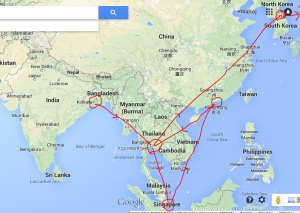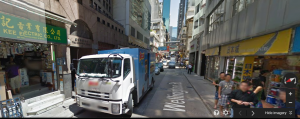
Homolog.us Reports from Asia - 'Will Hong Kong be the Bioinformatics Capital

Bioinformatics Research at the University of Hong Kong

In Hong Kong, I met the research groups of Professors T.-W. Lam and Francis Chin. I first became familiar with the work from Professor Chin’s group after reading about IDBA in the SPAdes paper. That was covered in a blog post in 2012. Separately, Heng Li mentioned about Professor Lam’s elegant 2-way BWT paper, and I have been following the publications from their group since then.

Based on reading their papers, I was aware that they have built an effective and confident team of bioinformatic researchers and took leadership in multiple areas (use of GPU in bioinformatics, assembly algorithms, alignment algorithms using BWT). The biggest surprise after visiting them was to find out how young most members in the group were.
L3 Bioinformatics

Ruibang and Professor Lam started a company named L3 bioinformatics and I was fortunate to visit them as well. When they mention ‘young and energetic’ in the description, they do really mean it !
L3 is a young and energetic company where IT talents, renowned professors and top-notch industrial partners like BGI work together to invent and develop the future computing technologies for bioinformatics.
It’s never easy to develop state-of-the-art technology which advances genomics analysis. We need biologists who understand the bleeding edge problems in genomics analysis. We need experts who knows how to design advanced algorithms to cope with the problems. We need seasoned IT engineers who know how to put together the right computing architecture for the designed solutions. And perhaps the hardest of all, we need a team of all above-mentioned, who can work together.
L3 is such a team.
My talk
I gave a talk at HKU and the theme was what to do with so much sequencing. The answer to that question would be helpful for bioinformaticians choose direction for building their tools.
The conventional wisdom says cheap sequencing should be used to sequence the genomes of millions of people (or Arabidopsis strains), and then align and compare to find associations with functional properties or diseases. I came to realize that strategy as wrong, and a better way to proceed would be to start with the fundamental (unanswered) questions in living systems and then use sequencing and bioinformatics to solve them. This may or may not work, but just like mathematics grew immensely through the efforts to solve unsolved problem (e.g. group theory), bioinformatics and biology can do the same.
About University of Hong Kong
University of Hong Kong started in the same year as the revolution against Qing dynasty began in China. There were stronger connections between those two events. Sun Yat-sen, who became the new leader of China, studied in Hong Kong College of Medicine for Chinese , the precursor of University of Hong Kong. During the next 60 years of turmoil, Hong Kong University was fortunate to be outside China and survived in its entirety with all departments.
The major improvements to the university came in the last three decades, and its program is now very modern and competitive with all other universities around the world. IMHO, Chinese students with knowledge of math is their biggest asset. I stopped by the theoretical physics department, and met Professor Jian Wang. His group has been doing outstanding work in theoretical physics in areas very similar to my PhD thesis. Another group led by Professor Fuchun Zhang is working on condensed matter theory, which was my area of major interest during PhD days.
Based on reading their papers and comments from US researchers working in the same field, they now lead the theoretical research. The same is very likely to happen to bioinformatics, if it has not happened already.
About Hong Kong
This was my first ever visit to Hong Kong, and I found the place teeming with life even on a late Sunday evening. Before reaching there, I checked google map street view to find my place of stay. Everything turned out to be alright except for two small problems. Firstly, I did not realize that the apparently flat streets in google map were actually up and down a fairly steep hill. Secondly, a big fat truck was sitting in front of the tiny alley in the google map view. Not only that truck was gone by the time I reached there, but three out of four surrounding stores were also gone. Shops disappear as fast as trucks near the dynamic Central/SOHO area of Hong Kong.

Discount airlines of Asia
I almost missed my chance to visit University of Hong Kong, were it not for my procrastination and discount airlines. Yes, procrastination helped me make this trip happen.
Here is how. While planning my trip from India, I emailed Ruibang to check about their availability, but did not get any reply for several days. Usually he is prompt with emails except when he makes business trips inside China or works on another mega-paper. This turned out to be neither as I later found out by checking with Professor Lam. This time, my email got lost in transit.
Thanks to not buying plane tickets until the last moment (hours before starting the trip), I could make a small tweak in the travel plan and add Hong Kong in the wish list. Then Ruibang, Professor Lam and the super-efficient secretary at their department managed to schedule my talk with just one day notice.
The real message here is that, in Asia, one can plan and tweak one’s trip until the last moment, because one can always find a really inexpensive ticket from myriads of discount airlines. Just buy and hop into one-way flights from Indigo, Air Asia, Tiger Air, Scoot Airlines and think about the next leg later. For hotel stay, I often used airbnb.
I took Thai Airlines from Kolkata to Bangkok, Air Asia from Bangkok to Singapore, Tiger Air from Singapore to Hong Kong, Air Asia from HK back to Bangkok - all individual one-way segments.
Summary and Comparison of Hong Kong/Singapore
In the following post, I will cover Singapore and compare the two cities based on my experience and limited perspectives.